The 9K35 Strela 10 is a short-range surface-to-air missile system designed in the 1970s by USSR. Based on a versatile platform, the MT-LB tracked vehicle, it presents a low profile and its large useful internal space is used for spare missiles. Its twin-arm, pairs launch canisters are visually aimed, using optical and infrared-guidance to fire the short range 9M333 (or 9M37MD) missile, primarily to engage low-altitude threats such as helicopters. GRAU "9K35", NATO reporting name SA-13 "Gopher". The number buult are unknown and they saw action in multiple wars from 1979 Angola to Ukraine in 2022-24. It was declined into six variants and exported to 30 countries.
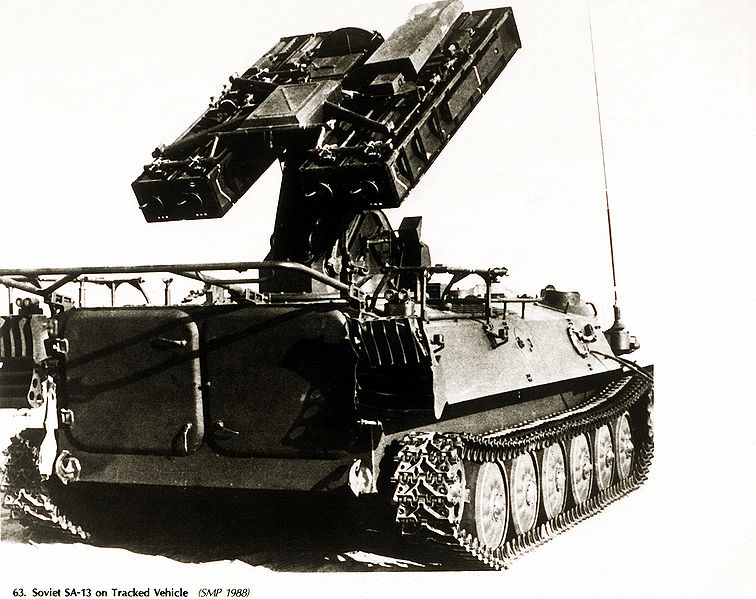
US Intel publication on the first 1976 vehicle, rear view
The 9K35 was stated a the successor of the 9K31 Strela-1 and was not only tracked, but can also fire the former missiles of the new 9M37. It started as the "9K37 Strela-10SV" by July 24, 1969. Decision for this new non-all-weather system was done in parallel to the all-weather gun/missile 2K22 "Tunguska" with the justification of making a cheaper alternative that can be adapted on all MT-LBs in the inventory in case of war. The specifications called for a faster reaction system, immune to last generation radio-frequency jamming.
The 9K35 Strela was basically a replacement for the 9K31 Strela 1 or SA-9 Gaskin, procuring better mobility, with a longer range, more lethal missile and it was done in parallel with the 2K22 Tungusk (SA-19 Grison) to provide a backup in heavily jammed environments. It was to be able to engage incoming targets up to 415 m/s as well as receding targets at 310 m/s up to 3,500 m ceiling and 5,000 m range. The missiles themselves had to support between 3 and 5G. The launcher and targeting were semi-autonomous for point defence, and to be air transportable by An-12 Cub or Mi-6 helicopter as well as amphibious. Tasked were separated with the Nudelman bureau for the missile design and Geofizika for its seeker.
Instead of the previous 4x4/8x8 BRDM-2 as the 9K31, the 9K35 used a modified MT-LB. The latter was designed as a supply tracked utility carrier and APC. Longer and larger, but also offering a lower profile, it still offered a roomy rear compartment than can be use to store the reload system, the operator and its tracking equipments and spare missiles. The amphibious capability was retained during development, despite the massive weight added, by providing polyurethane-filled floats. However the 9K35 was by default recoignised as not amphibious (capable of swimming).
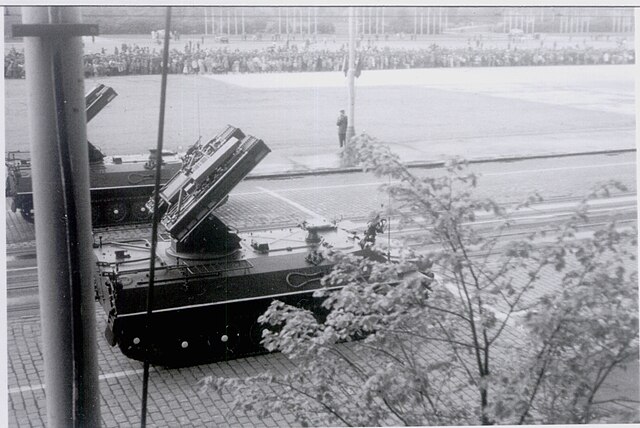
9A34 vehicles in parade, 1985.
The Strela-10SV system was developed around the new 9M37 missile. The latter were tested at the Donguzkom range from 1973 to 1974 but the program left to be desired, with a poot first kill probability. The MT-LB as a platform was nor as reliable when combined with the launcher a lot of fixes and further tests were needed before the final acceptance into service on May 16, 1976, seven years after the start of the programme.
Development continued the following later 1970-80s and generated variants such as the Strela-10M, 10M2 and 10M3. They broughts improved radio communications and better interfacing and dataling into the new Soviet integrated air defence system. Improved missiles such as the 9M37M and 9M333 improved reactions time, speed range, payload, and jamming proofing as well. By September 2007, the ultimate 9K35M3-K Kolchan was a variant mounted on the old BTR-60 wheeled chassis in order to propose an adaptation to customers operating this APC and providing an organic AA defense system. The 9K35M3-K was revealed poublicly at the Moscow Air Show MAKS 2007.

Serbian variant 10M2J Sava VS3
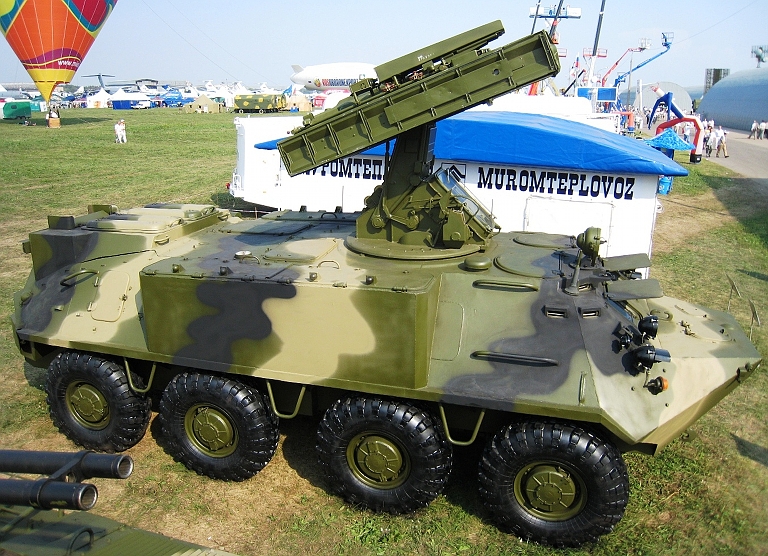
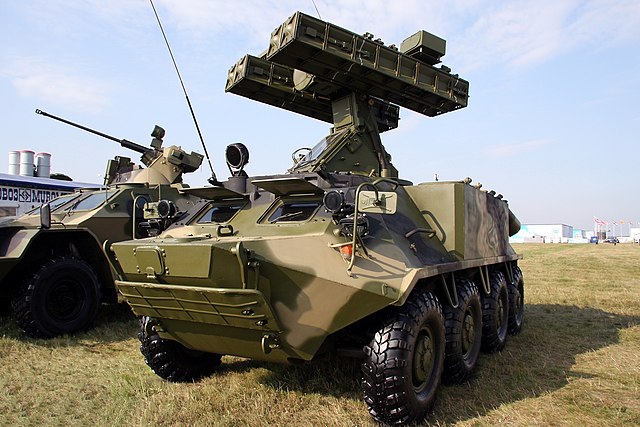
9A34M3-K TELAR, adpated on a completely refusrbished BTR-60PBM 8x8 amphibious personnel carrier. Unlike previous systems, it has a new electro-optical fire control sensor package above the RHS launchers. The magazines for four reload rounds needs a hull extension on either side, presenting flat sides. The aft section had been reworked as well. The BTR-60PB presents a higher profile but greater speed and lower maintenance. Like the original, the four canister launcher in addition can be folded down to lower its profile.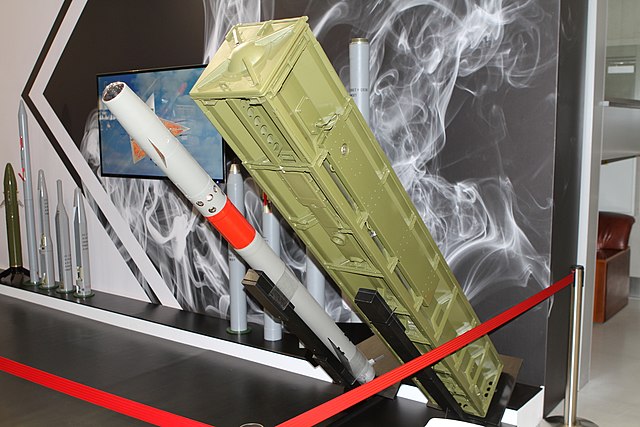
9M333 missile
The Strela-10 system linked to the 9M37 missile had a launch system designed to be backwards compatible with the 9M31M missile (9K31 Strela-1). These are 2,200 mm (7.2 ft) long for 40 kg (88 pounds) and carrying 3.5 kg (7–15 pound) warhead. They are a relative to the first soviet IR missiles like the K13 (AA-2 Atoll), with a maximum speed near Mach 2 and capable of hitting a target from 800 to 5000 m (0.3–3 miles) which was later improved for short distances. Combat ceiling ranged from as low as 10 meters and max 3,5 km (33-11,500 ft). These all varied between the target's own speed, altitude parameters and flight direction.
Four of such 9M37 missiles are mounted on the launcher arm called a "turret" since it had a remote sight and two arms. The canisters are paired on each one. This launcher, inspired by types used in the Navy, are capable of 360° traverse and a 90° elevation. Eight more are stored as spares inside the vehicle, as reloads, a process that takes 3 minutes. This led to a tactic of keeping on each battery at least a single vehicle as stand guard to avoid any surprises during this time.
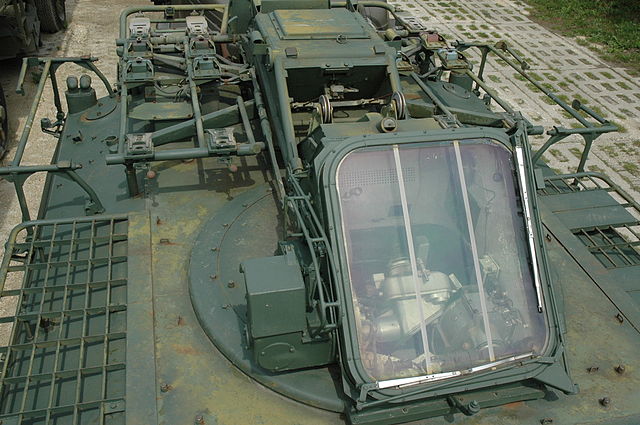
Folded launcher and small cabin for the operator.
The 9M37 was replaced in 1979 by the 9M37M which had a more efficient autopilot for its flight path control. Later appeared in 1981 the much upgraded 9M333, whjch combined a heavier warhead still with expanding-rod but larger HE, new proximity fuse with 8-ray laser to engage other missiles or UAVs, a triple-channel (instead of fual) for the guidance system to foil countermeasure and improved engine for better performance in the same package. All used an optical homing head. It is equipped with a reticle-based photocontrast combined with infrared homing. The photocontrast channel for the earlier models are used as back-up method.
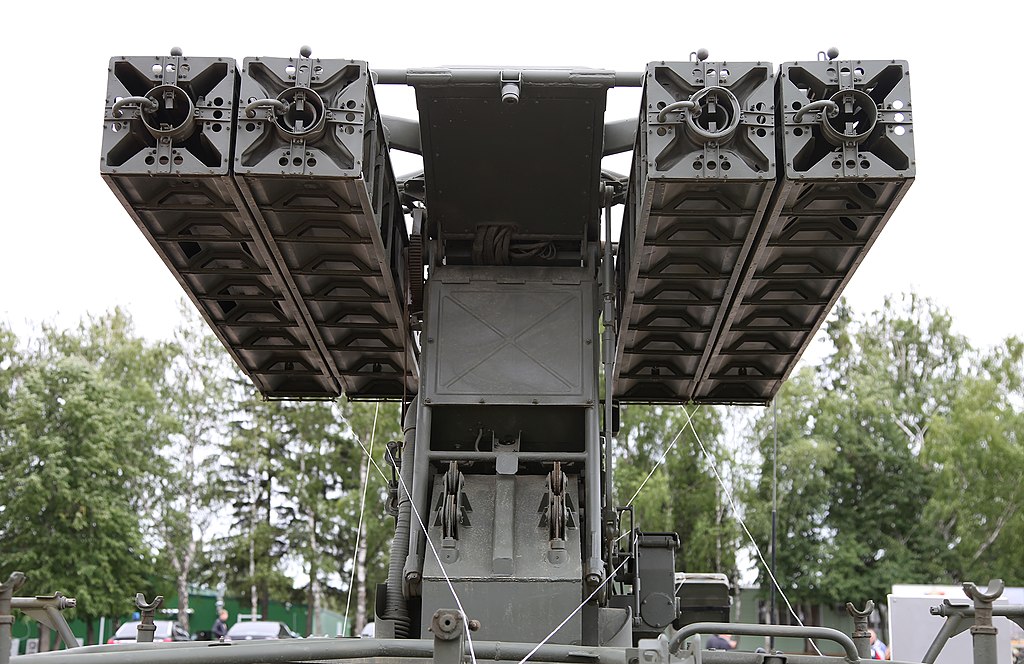
Close view on the hermetically sealed launch tubes, tank bihatlon 2014.
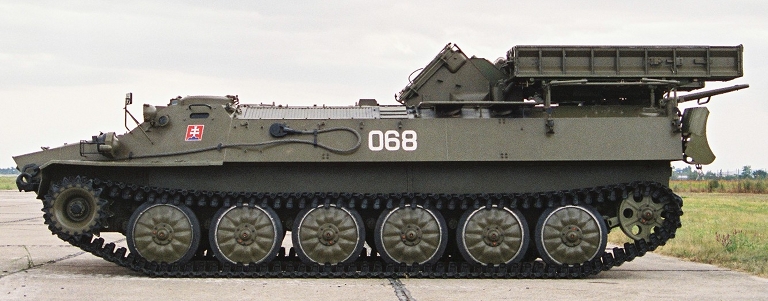
Slovak 9A34M, launcher folded, by Miroslav Gyuriosi
-9T244/9T245 Missile Transporter and Transloader based on an Ural 4320 truck
-PU-12M or 9S738-3 Mobile Command Post (BTR-60 based)
-P-40/1S12 Long Track self Propelled Acquisition Radar (based on the AT-T tractor)
-9V839 or 9V915 Missile Repair and Test Station vehicle (based on the GAZ-66)
-Main repair Station truck (P-15, P-18, P-19, P-40 variants, based ZIL-131)
-9F624M Mobile Training Simulator (Ural-375)
9K33M3 optional vehicles:
-P-15M Squat Eye UHF-Band Low Level Acquisition Radar based on an Ural-375
-P-15/19 "Flat Face" UHF-Band Acquisition Radar based on an Ural-375
-1L22 Parol 4/75E6 Parol 3 IFF Interrogator based on a KrAZ-255
-PRV-16 "Thin Skin" Heightfinding Radar, self propelled.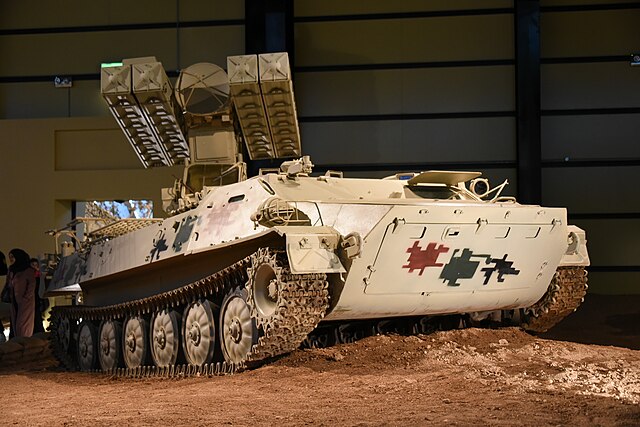
Jordanian 9K35 Strela 10 at the Royal Tank Museum of Amman
 Afghanistan, 16 captured before 1992 seeing action until 1996.
Afghanistan, 16 captured before 1992 seeing action until 1996.
 Angola. Unknown numbers, used in combat 1980s.
Angola. Unknown numbers, used in combat 1980s.
 Amenia: As successor state, unknown numbers.
Amenia: As successor state, unknown numbers.
 Azerbaidjan: As successor state, unknown numbers.
Azerbaidjan: As successor state, unknown numbers.
 Belarus: As successor state, unknown numbers.
Belarus: As successor state, unknown numbers.
 Bulgaria: Unknown number as Warsaw pact, retired.
Bulgaria: Unknown number as Warsaw pact, retired.
 Cuba: 200+ transferred and extant c2023.
Cuba: 200+ transferred and extant c2023.
 Croatia: 9 M3 and 6 Strela-10CRO, locally upgraded.
Croatia: 9 M3 and 6 Strela-10CRO, locally upgraded.
 Warsaw Pact, and successor state, unknown numbers.
Warsaw Pact, and successor state, unknown numbers.
 Georgia: As successor state, unknown numbers.
Georgia: As successor state, unknown numbers.
 Hungary: Under warsaw Pact, unknown, withdrawn.
Hungary: Under warsaw Pact, unknown, withdrawn.
 India: Unknown, c200 2012, upgraded with local EO systems and 9M333 missile.
India: Unknown, c200 2012, upgraded with local EO systems and 9M333 missile.
 Iraq: Acquired 1980s, unknown numbers, some destroyed 1992 remainder Iraq War 2003.
Iraq: Acquired 1980s, unknown numbers, some destroyed 1992 remainder Iraq War 2003.
 Jordan: Likely M3, 92 in service in 2023
Jordan: Likely M3, 92 in service in 2023
 Kazakh. As successor state, unknown numbers.
Kazakh. As successor state, unknown numbers.
 Kyrgyz. As successor state, unknown numbers.
Kyrgyz. As successor state, unknown numbers.
 Laos: Unknown numbers.
Laos: Unknown numbers.
 Libya: 60 in 1992, destroyed during the civil war.
Libya: 60 in 1992, destroyed during the civil war.
 North Macedonia: 8 total.
North Macedonia: 8 total.
 Mongolia: Possibly 1990s, no more in service.
Mongolia: Possibly 1990s, no more in service.
 N. Korea: Listed but unknown numbers.
N. Korea: Listed but unknown numbers.
 Poland: As per the Warsaw pact, 4 retired 2000s.
Poland: As per the Warsaw pact, 4 retired 2000s.
 Serbia: 18 in service today.
Serbia: 18 in service today.
 Slovakia: As successor state, Withdrawn.
Slovakia: As successor state, Withdrawn.

 Still 350 with 9M333 and 100 Strela-10MNs in 2012–2020.
Still 350 with 9M333 and 100 Strela-10MNs in 2012–2020.
 Uknown numbers transferred.
Uknown numbers transferred.
 Turkm. As successor state, 13.
Turkm. As successor state, 13.
 Ukraine. Unknown numbers, withdrawn, 6 donated by Czech Republic.
Ukraine. Unknown numbers, withdrawn, 6 donated by Czech Republic.
 20 in service 2012.
20 in service 2012.
 As successor state, Withdrawn, passed on to Serbia, etc.
As successor state, Withdrawn, passed on to Serbia, etc.
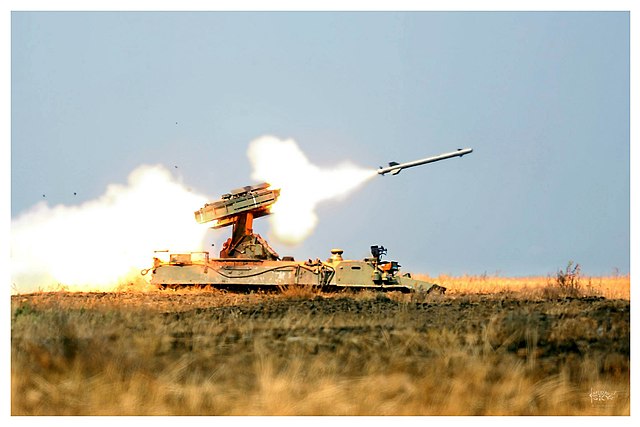
Ukrainian vehicle firing
The system was deployed in the 1980s as complementary to the Tunguska system. Typically there was a single 9A35 for three 9A34 albeit they all shared the same missiles, but only the A35 had the 9S86 "Snap Shot" radar and datalink for the two others in case no accompanying vehicle was present. All carried four ready missiles, plus four stowed reloads, sometimes four more in external cradles. The battery was completed by a PPRU-1/1M (based on the MT-LBu) command post or PU-12M command post. The former has a X-band 9S80/9S80M/M1 Ovod (NATO "Dog Ear") battery acquisition radar. The upgraded PPRU-1M-2 (based on the MT-LBu) had a new planar array solid state digital 9S80M1-2 radar.
The battery is assisted with a variable array of vehicles, assigned to several batteries at Batallion level: The 9T244/9T245 Missile Transporter and Transloader based on an Ural 4320 truck, the PU-12M or 9S738-3 Mobile Command Post (BTR-60 based), the P-40/1S12 Long Track self Propelled Acquisition Radar (based on the AT-T tractor), the 9V839 or 9V915 Missile Repair and Test Station vehicles based on the GAZ-66 truck, generally two per battery, a ZIL-131 converted as main repair Station (P-15, P-18, P-19, P-40 variants), the 9F624M Mobile Training Simulator based on an Ural-375 truck, and a stock of 48 9K37M Missiles per battery. The system was exported widely and still kept in the Soviet inventory to this day with c350 ported to the M3 standard.
The vehicle saw combat first in the Angolan Civil War and by February 20, 1988, a first Mirage F1AZ was shot down by a Cuban battery based in Cuatir (Menongue) over Southern Angola. Next, the vehicke saw action during Operation Desert Storm with the few Iraqi batteries targeted in 1991, all assigned to the elite Republican Guard divisions. In total, 27 coalition aircraft were hit by IR-homing SAMs, with 14 losses. One crashed landed and the rest were total losses. On February 15 an A-10A of 353rd TFS/354th was believed to be shot down specifically by a Strela-10 100 km northwest of Kuwait City, the pilot ejected and became a POW. His wingman was also hit and killed.
The Strela 10 saw action in ex-Yugoslavia, during the Kosovo War in the hands of Serbians during the NATO bombing campaign, claiming one USAAF A-10 on 11 May 1999. It saw action as well in the Syrian Civil War when on April 14, 2018, allied forces launched 105 air-to-surface and cruise missiles on eight sites in Syria as retaliation after gas attacks on civilians. Russian sources claimed five launched, three hits, but i was denied by the US DoD in a press briefing. Closer to us, the Strela 10 also saw action in the 2020 Nagorno-Karabakh conflict, used by the Armenian Air Defense in the opening days, but some were destroyed by Azerbaijani Bayraktar TB2 armed drones.
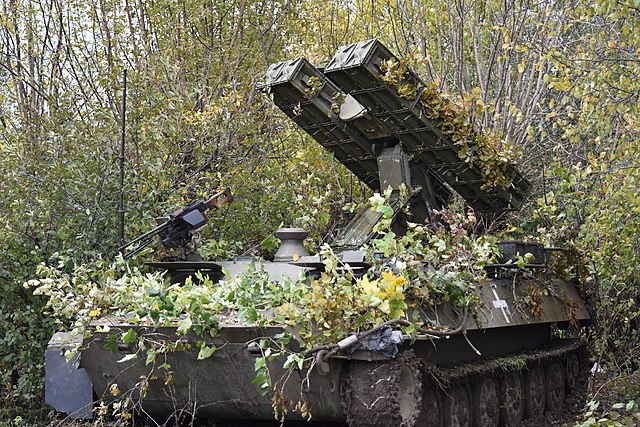
Ukrainian system of the 30th Brigade
Since the Russian Invasion of Ukraine in 2022, the Strela-10 had been used on both sides, the Ukrainian Armed Forces. One Russian Strela-10M on Snake Island was destroyed by a Bayraktar TB2 on 30 April 2022. One Ukrainian 10M system was claimed near Lisichansk on 17 June 2022. During the Wagner Group rebellion a Strela-10 almost hit a Russian Army Ka-52 helicopter near Voronetzh while another decoy Wagner's missiles, using its flares. The Strela-10M had a planned replacement, the Sosna anti-aircraft missile system. The system is based on the MT-LB chassis consisting of 12 Sosna-R 9M337 beam rider missiles with a range of 10 km and altitude of 5 km.
Said Aminov, Vestnik PVO
Peter Skarus, Peter's ADA - Theorie und Grundlagen der Fla
Ralf Wagner, Fla-Rakete 9K37M, Flak-11 Die Truppen-luftabwehr (TLA) der 11. MSD
H. Kaiser, Raketen- und Waffentechnischer Dienst im Kdo. MB III
on militaryfactory.com
defencetalk.com
www.army.cz
armyrecognition.com
weaponsystems.net
militarytoday.com
ausairpower.net
odin.tradoc.army.mil
en.wikipedia.org/
kyivpost.com
nuou.org.ua
scalemates.com
Development of the 9K35

US Intel publication on the first 1976 vehicle, rear view
The 9K35 was stated a the successor of the 9K31 Strela-1 and was not only tracked, but can also fire the former missiles of the new 9M37. It started as the "9K37 Strela-10SV" by July 24, 1969. Decision for this new non-all-weather system was done in parallel to the all-weather gun/missile 2K22 "Tunguska" with the justification of making a cheaper alternative that can be adapted on all MT-LBs in the inventory in case of war. The specifications called for a faster reaction system, immune to last generation radio-frequency jamming.
The 9K35 Strela was basically a replacement for the 9K31 Strela 1 or SA-9 Gaskin, procuring better mobility, with a longer range, more lethal missile and it was done in parallel with the 2K22 Tungusk (SA-19 Grison) to provide a backup in heavily jammed environments. It was to be able to engage incoming targets up to 415 m/s as well as receding targets at 310 m/s up to 3,500 m ceiling and 5,000 m range. The missiles themselves had to support between 3 and 5G. The launcher and targeting were semi-autonomous for point defence, and to be air transportable by An-12 Cub or Mi-6 helicopter as well as amphibious. Tasked were separated with the Nudelman bureau for the missile design and Geofizika for its seeker.
Instead of the previous 4x4/8x8 BRDM-2 as the 9K31, the 9K35 used a modified MT-LB. The latter was designed as a supply tracked utility carrier and APC. Longer and larger, but also offering a lower profile, it still offered a roomy rear compartment than can be use to store the reload system, the operator and its tracking equipments and spare missiles. The amphibious capability was retained during development, despite the massive weight added, by providing polyurethane-filled floats. However the 9K35 was by default recoignised as not amphibious (capable of swimming).

9A34 vehicles in parade, 1985.
The Strela-10SV system was developed around the new 9M37 missile. The latter were tested at the Donguzkom range from 1973 to 1974 but the program left to be desired, with a poot first kill probability. The MT-LB as a platform was nor as reliable when combined with the launcher a lot of fixes and further tests were needed before the final acceptance into service on May 16, 1976, seven years after the start of the programme.
Development continued the following later 1970-80s and generated variants such as the Strela-10M, 10M2 and 10M3. They broughts improved radio communications and better interfacing and dataling into the new Soviet integrated air defence system. Improved missiles such as the 9M37M and 9M333 improved reactions time, speed range, payload, and jamming proofing as well. By September 2007, the ultimate 9K35M3-K Kolchan was a variant mounted on the old BTR-60 wheeled chassis in order to propose an adaptation to customers operating this APC and providing an organic AA defense system. The 9K35M3-K was revealed poublicly at the Moscow Air Show MAKS 2007.
Production
Production started in 1976 and never stopped completely, although its pace was slowed down considerably in the 1990s. The name Strela-10SV applied to the prototype but the production version was Stral-10 until new variants appeared. Until 1991, production figures remains ellusive. By 1991 Russian still had some 350 back in 2023 plus 100 of another modernized type, and exports amounted to c500 bringing the total of c1,000 at the least.Design of the 9K35 Strela-10
Hull and general design
The MT-LB had a low-silhouette with a box-like, all welded steel hull. The crew compartment was placed at the front was large enough for a driver and co-driver. On the Strela 10 there was no ball-mounted machine gun or top turret over the position. The engine was placed immediately behind, on the left side. The troop compartment of the regular vehicle kept its two access doors at the rear but not the roof panels as it was completely modified to allow the loading of four missiles when the launcher arm atop was in the right position. Instead of the original ten infantrymen there was a completely new mechanical system for the launcher, and a small unit for one operator, also called the gunner. The rest of the crew comprised the driver on the left and co-driver/commander on the right, each having access to their individual hatch. There was enough space for three seats frontally but the center hosted the transmission tunnel and the external position was often occupied by various systems.Powerplant & Performances
The vehicle like the MT-LB is powered by a front mounted YaMZ-238 V diesel rated for 240 hp. Fuel capacity is 450 litres and range 500 km, top speed 61.5 km/h on road and 6 km/h on water. Ground clearance is 0.5 m. The vehicle is characterized by flat-track suspension with six road wheels of the standard stamped model, without return rollers, and torsion bars. But it can be fitted with extra-wide-track (565 mm wide vs 350) with an "aggressive" grouser for snow/swamp normally impassable ground as the MT-LBV helping to reduce ground pressure from 0.46 to only 0.28 kg/cm2. However the Strela 10 vehicle was heavier. The standard MT-LB weighted 11.900 kgs versus 12,300 kgs.Protection, passive and active
The vehicle was protected by a 7 mm armor plate at all angles, however the turret front and frontal arc nose armor was 0.55 in (14 mm) thick, enough with the sloped armor to deflect heavy MG rounds. NBC collective protection system was standard, with internal spall lining. The Strela 10 had no smoke projectors.Armament
Outside the Main missile launcher, it was reduced to just a single 7.62 mm PKMB GMPG on a pintle in front of the co-driver's hatch (c2000 rounds). The latter needed to open the hatch and raised himself to operate it. Some variants shows a small protective shield, but this was an exposed position.9K35 Strela-10 specifications M3 | |
| Dimensions (L-w-h) | 6,6 x 2,85 x 2,3m (travelling), 3,8m (firing) |
| Total weight, battle ready | 12,300 kg |
| Crew | 3: Commander, Driver, Operator. |
| Propulsion | YaMZ-238 V diesel 240 hp |
| Top speed | 61.5 km/h (road), 6 km/h (water) |
| Suspensions | Torsion bars |
| Range | 500 km/310 miles |
| Armament | 1×4 9M37/37M/333/37MD, 1x PKMB LMG |
| Armor | Max 14 mm |
| Production | Unknown, c1000 |
Variants
9A35 Strela 10SV (1976)
Basic vehicle and system in production until 1979. Unknown numbers. The missiles uses proximity + impact fuse, their seeker head is two-channel, 9E47 Virazh, two colour infrared/visible band seeker with AM-modulated photocontrast (cooled PbS) and FM-modulated uncooled IR system, range 5 km, altitude 3500 km at 517 m/sec.9A34 TELAR (1976)
The 9A34 was developed as an "austere" variant at the same time on the same chassis and same launcher arm, with more produced. Whereas 9A35 employs a pulse Doppler millimetric band 9S86 "Snap Shot" with radial velocity as a finding radar. While the 9A35 has the 9S16 Flat Box-B radio-frequency passive detection system, the variant 9A34 lacked it. Its Flat Box antenna suite was mounted above the MT-LB hull froward, and more above the TELAR turret. The 9A34A Gryuza uses the Azovsky L-136 MAK-F infrared search and track system. It is capable of passive acquisition of a jet at 10-15 km range, day or night as an Upgrade.9A35M/9A34M Strela 10M (1979)
The improved 9K37M Strela-10M goes with the 9E47M seeker studied in 1977 and produced from 1979.9A35M2/9A34M2 Strela 10M2 (1981)
Further improved version, see the missile for more.9A35M3/9A34M3 Strela 10M3 (1989)
Using an eight laser ray for proximity, improved 9Sh127 optical sighting system for the gunner with WFOV and NFOV modes.
Serbian variant 10M2J Sava VS3
9K34M3-K Kolchan (2007)


9A34M3-K TELAR, adpated on a completely refusrbished BTR-60PBM 8x8 amphibious personnel carrier. Unlike previous systems, it has a new electro-optical fire control sensor package above the RHS launchers. The magazines for four reload rounds needs a hull extension on either side, presenting flat sides. The aft section had been reworked as well. The BTR-60PB presents a higher profile but greater speed and lower maintenance. Like the original, the four canister launcher in addition can be folded down to lower its profile.
9A35M4/9A34M4 Strela 10M4 (2013)
In 2014, the Russian Airborne Troops received a first batch of 18 Strela-10M4. The Russian Armed Forces ordered 72 Strela-10M4 by 2016. Modernization was done oon older systems to give them another 3–5 years of useful service.9S16 Flat Box RF Passive Detection System
Not a full new vehicle but an upgrade. This is an add-on to existing M3 systems with sensors designed to cue the 9A35M, exploiting radar emissions. It presnets multiple antennas mountrf over the MT-LB's forward center section (between the driver and co-driver positions) with an additional antenna mounted over the TELAR turret. The level of performance and band coverage are still classified.9M37 Missile and Variants

9M333 missile
The Strela-10 system linked to the 9M37 missile had a launch system designed to be backwards compatible with the 9M31M missile (9K31 Strela-1). These are 2,200 mm (7.2 ft) long for 40 kg (88 pounds) and carrying 3.5 kg (7–15 pound) warhead. They are a relative to the first soviet IR missiles like the K13 (AA-2 Atoll), with a maximum speed near Mach 2 and capable of hitting a target from 800 to 5000 m (0.3–3 miles) which was later improved for short distances. Combat ceiling ranged from as low as 10 meters and max 3,5 km (33-11,500 ft). These all varied between the target's own speed, altitude parameters and flight direction.
Four of such 9M37 missiles are mounted on the launcher arm called a "turret" since it had a remote sight and two arms. The canisters are paired on each one. This launcher, inspired by types used in the Navy, are capable of 360° traverse and a 90° elevation. Eight more are stored as spares inside the vehicle, as reloads, a process that takes 3 minutes. This led to a tactic of keeping on each battery at least a single vehicle as stand guard to avoid any surprises during this time.

Folded launcher and small cabin for the operator.
The 9M37 was replaced in 1979 by the 9M37M which had a more efficient autopilot for its flight path control. Later appeared in 1981 the much upgraded 9M333, whjch combined a heavier warhead still with expanding-rod but larger HE, new proximity fuse with 8-ray laser to engage other missiles or UAVs, a triple-channel (instead of fual) for the guidance system to foil countermeasure and improved engine for better performance in the same package. All used an optical homing head. It is equipped with a reticle-based photocontrast combined with infrared homing. The photocontrast channel for the earlier models are used as back-up method.

Close view on the hermetically sealed launch tubes, tank bihatlon 2014.
9M37
The 9M37 is an enlarged and more capable version of the earlier 9M31 missile and is fitted with an improved infra-red seeker. The missile has a conventional layout with the seeker in the front, followed by the warhead and the rocket engine. It is transported and launched from a ribbed container.9M37M/MD
Improved 9M37 that features a further improved infra-red seeker. The 9M37MD is a 9M37M missile fitted with a heavier and more capable warhead.9M333
The 9M333 is the latest missile for the 9K35 system and is a further improvement of the 9M37MD. It features a dual mode seeker with photo contrast and passive infra-red guidance. The 9M333 has a much better resistance to flares and decoys and is able to lock on to smaller targets such as UAV's and cruise missiles.
Slovak 9A34M, launcher folded, by Miroslav Gyuriosi
Associated Vehicles
PPRU-1M-2 Battery Command Post and Acquisition Radar (2008)
A recent variant called the PPRU-1M-2, based on the BT-LBu presenting a full digital display console for two operators in the rear compartment as well as new design solid state VNIIRT 9S80M1-2 system to replace the old "Dog Ear" system. Others are listed below:-9T244/9T245 Missile Transporter and Transloader based on an Ural 4320 truck
-PU-12M or 9S738-3 Mobile Command Post (BTR-60 based)
-P-40/1S12 Long Track self Propelled Acquisition Radar (based on the AT-T tractor)
-9V839 or 9V915 Missile Repair and Test Station vehicle (based on the GAZ-66)
-Main repair Station truck (P-15, P-18, P-19, P-40 variants, based ZIL-131)
-9F624M Mobile Training Simulator (Ural-375)
9K33M3 optional vehicles:
-P-15M Squat Eye UHF-Band Low Level Acquisition Radar based on an Ural-375
-P-15/19 "Flat Face" UHF-Band Acquisition Radar based on an Ural-375
-1L22 Parol 4/75E6 Parol 3 IFF Interrogator based on a KrAZ-255
-PRV-16 "Thin Skin" Heightfinding Radar, self propelled.
Users

Jordanian 9K35 Strela 10 at the Royal Tank Museum of Amman
 Afghanistan, 16 captured before 1992 seeing action until 1996.
Afghanistan, 16 captured before 1992 seeing action until 1996. Angola. Unknown numbers, used in combat 1980s.
Angola. Unknown numbers, used in combat 1980s. Amenia: As successor state, unknown numbers.
Amenia: As successor state, unknown numbers. Azerbaidjan: As successor state, unknown numbers.
Azerbaidjan: As successor state, unknown numbers. Belarus: As successor state, unknown numbers.
Belarus: As successor state, unknown numbers. Bulgaria: Unknown number as Warsaw pact, retired.
Bulgaria: Unknown number as Warsaw pact, retired. Cuba: 200+ transferred and extant c2023.
Cuba: 200+ transferred and extant c2023. Croatia: 9 M3 and 6 Strela-10CRO, locally upgraded.
Croatia: 9 M3 and 6 Strela-10CRO, locally upgraded. Warsaw Pact, and successor state, unknown numbers.
Warsaw Pact, and successor state, unknown numbers. Georgia: As successor state, unknown numbers.
Georgia: As successor state, unknown numbers. Hungary: Under warsaw Pact, unknown, withdrawn.
Hungary: Under warsaw Pact, unknown, withdrawn. India: Unknown, c200 2012, upgraded with local EO systems and 9M333 missile.
India: Unknown, c200 2012, upgraded with local EO systems and 9M333 missile. Iraq: Acquired 1980s, unknown numbers, some destroyed 1992 remainder Iraq War 2003.
Iraq: Acquired 1980s, unknown numbers, some destroyed 1992 remainder Iraq War 2003. Jordan: Likely M3, 92 in service in 2023
Jordan: Likely M3, 92 in service in 2023 Kazakh. As successor state, unknown numbers.
Kazakh. As successor state, unknown numbers. Kyrgyz. As successor state, unknown numbers.
Kyrgyz. As successor state, unknown numbers. Laos: Unknown numbers.
Laos: Unknown numbers. Libya: 60 in 1992, destroyed during the civil war.
Libya: 60 in 1992, destroyed during the civil war. North Macedonia: 8 total.
North Macedonia: 8 total. Mongolia: Possibly 1990s, no more in service.
Mongolia: Possibly 1990s, no more in service. N. Korea: Listed but unknown numbers.
N. Korea: Listed but unknown numbers. Poland: As per the Warsaw pact, 4 retired 2000s.
Poland: As per the Warsaw pact, 4 retired 2000s. Serbia: 18 in service today.
Serbia: 18 in service today. Slovakia: As successor state, Withdrawn.
Slovakia: As successor state, Withdrawn.
 Still 350 with 9M333 and 100 Strela-10MNs in 2012–2020.
Still 350 with 9M333 and 100 Strela-10MNs in 2012–2020. Uknown numbers transferred.
Uknown numbers transferred. Turkm. As successor state, 13.
Turkm. As successor state, 13. Ukraine. Unknown numbers, withdrawn, 6 donated by Czech Republic.
Ukraine. Unknown numbers, withdrawn, 6 donated by Czech Republic. 20 in service 2012.
20 in service 2012. As successor state, Withdrawn, passed on to Serbia, etc.
As successor state, Withdrawn, passed on to Serbia, etc.
The 9A34/35 TELAR in action

Ukrainian vehicle firing
The system was deployed in the 1980s as complementary to the Tunguska system. Typically there was a single 9A35 for three 9A34 albeit they all shared the same missiles, but only the A35 had the 9S86 "Snap Shot" radar and datalink for the two others in case no accompanying vehicle was present. All carried four ready missiles, plus four stowed reloads, sometimes four more in external cradles. The battery was completed by a PPRU-1/1M (based on the MT-LBu) command post or PU-12M command post. The former has a X-band 9S80/9S80M/M1 Ovod (NATO "Dog Ear") battery acquisition radar. The upgraded PPRU-1M-2 (based on the MT-LBu) had a new planar array solid state digital 9S80M1-2 radar.
The battery is assisted with a variable array of vehicles, assigned to several batteries at Batallion level: The 9T244/9T245 Missile Transporter and Transloader based on an Ural 4320 truck, the PU-12M or 9S738-3 Mobile Command Post (BTR-60 based), the P-40/1S12 Long Track self Propelled Acquisition Radar (based on the AT-T tractor), the 9V839 or 9V915 Missile Repair and Test Station vehicles based on the GAZ-66 truck, generally two per battery, a ZIL-131 converted as main repair Station (P-15, P-18, P-19, P-40 variants), the 9F624M Mobile Training Simulator based on an Ural-375 truck, and a stock of 48 9K37M Missiles per battery. The system was exported widely and still kept in the Soviet inventory to this day with c350 ported to the M3 standard.
The vehicle saw combat first in the Angolan Civil War and by February 20, 1988, a first Mirage F1AZ was shot down by a Cuban battery based in Cuatir (Menongue) over Southern Angola. Next, the vehicke saw action during Operation Desert Storm with the few Iraqi batteries targeted in 1991, all assigned to the elite Republican Guard divisions. In total, 27 coalition aircraft were hit by IR-homing SAMs, with 14 losses. One crashed landed and the rest were total losses. On February 15 an A-10A of 353rd TFS/354th was believed to be shot down specifically by a Strela-10 100 km northwest of Kuwait City, the pilot ejected and became a POW. His wingman was also hit and killed.
The Strela 10 saw action in ex-Yugoslavia, during the Kosovo War in the hands of Serbians during the NATO bombing campaign, claiming one USAAF A-10 on 11 May 1999. It saw action as well in the Syrian Civil War when on April 14, 2018, allied forces launched 105 air-to-surface and cruise missiles on eight sites in Syria as retaliation after gas attacks on civilians. Russian sources claimed five launched, three hits, but i was denied by the US DoD in a press briefing. Closer to us, the Strela 10 also saw action in the 2020 Nagorno-Karabakh conflict, used by the Armenian Air Defense in the opening days, but some were destroyed by Azerbaijani Bayraktar TB2 armed drones.

Ukrainian system of the 30th Brigade
Since the Russian Invasion of Ukraine in 2022, the Strela-10 had been used on both sides, the Ukrainian Armed Forces. One Russian Strela-10M on Snake Island was destroyed by a Bayraktar TB2 on 30 April 2022. One Ukrainian 10M system was claimed near Lisichansk on 17 June 2022. During the Wagner Group rebellion a Strela-10 almost hit a Russian Army Ka-52 helicopter near Voronetzh while another decoy Wagner's missiles, using its flares. The Strela-10M had a planned replacement, the Sosna anti-aircraft missile system. The system is based on the MT-LB chassis consisting of 12 Sosna-R 9M337 beam rider missiles with a range of 10 km and altitude of 5 km.
Sources
Зенитный ракетный комплекс (модернизация ЗРК “Стрела-10М”, “Стрела-10М2”, “Стрела-10М3”)Said Aminov, Vestnik PVO
Peter Skarus, Peter's ADA - Theorie und Grundlagen der Fla
Ralf Wagner, Fla-Rakete 9K37M, Flak-11 Die Truppen-luftabwehr (TLA) der 11. MSD
H. Kaiser, Raketen- und Waffentechnischer Dienst im Kdo. MB III
on militaryfactory.com
defencetalk.com
www.army.cz
armyrecognition.com
weaponsystems.net
militarytoday.com
ausairpower.net
odin.tradoc.army.mil
en.wikipedia.org/
kyivpost.com
nuou.org.ua
scalemates.com
Illustration
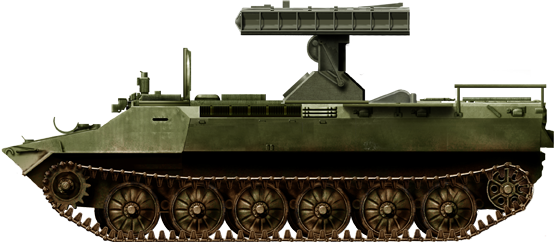
Base 9K34
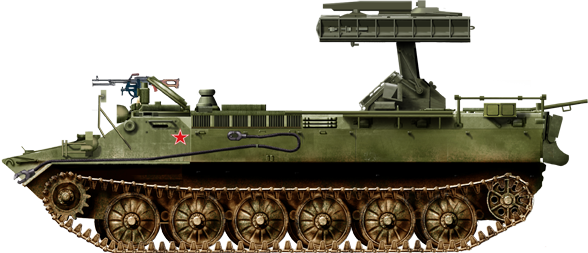
Base 9K35
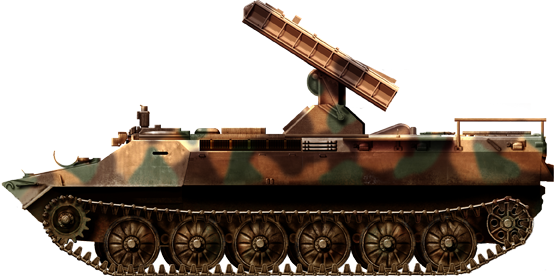
Strela 10 in Kabul Afghanistan 2001

Slokavian Stela 10
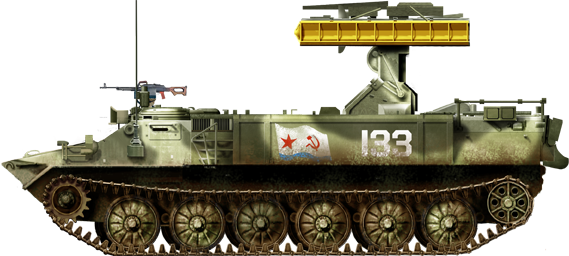
9K35 Soviet Navy
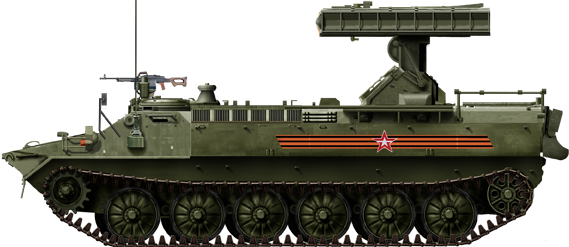
9K34M2 Donetz Parade
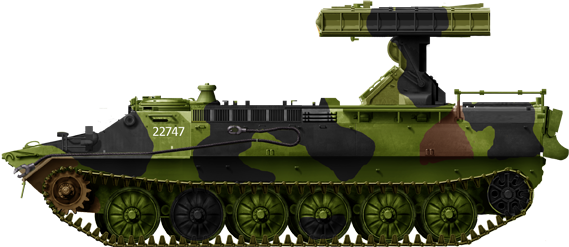
Serbian 9K34
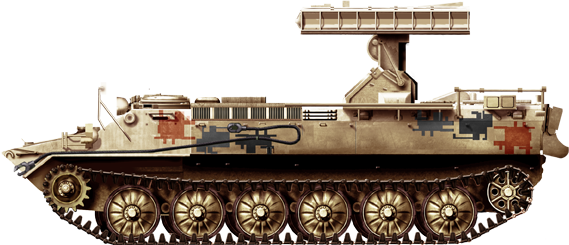
9K34 of the Royal Jordanian Army
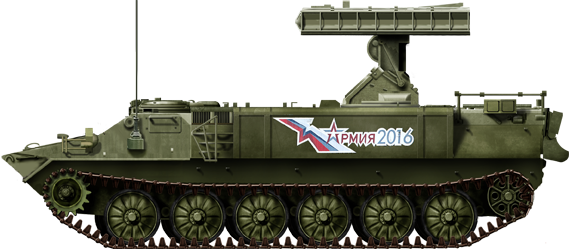
9K34M3 presented at Armiya 2016
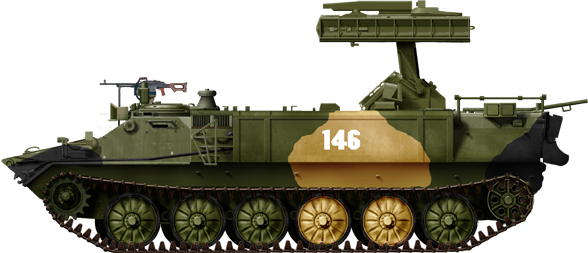
9K35M3 in modern Russian camouflage

Ukrainian 9K34M
Gallery
Strela-10 at the Artillery museum in Saint-Petersburg
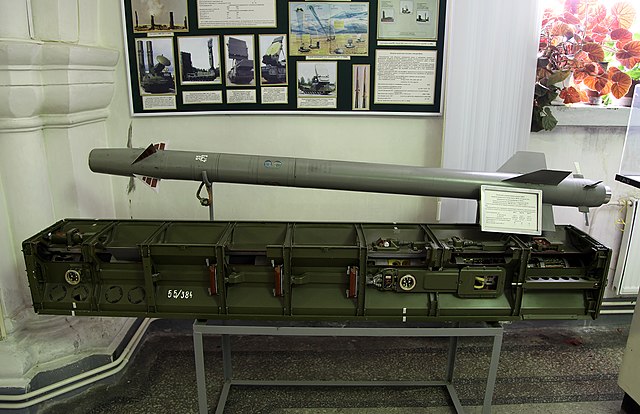
9M37 missile
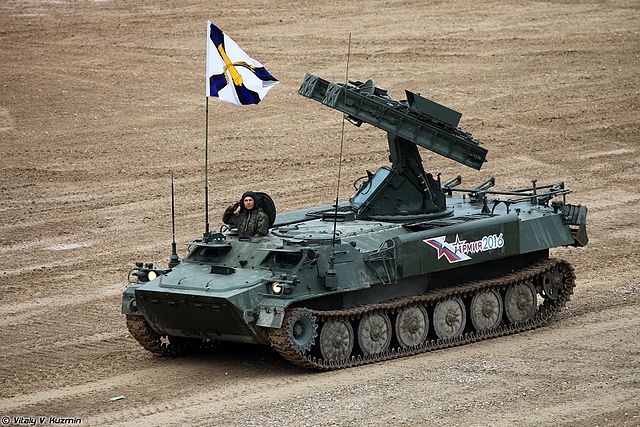
Armiya 2016 demo Strela-10M3
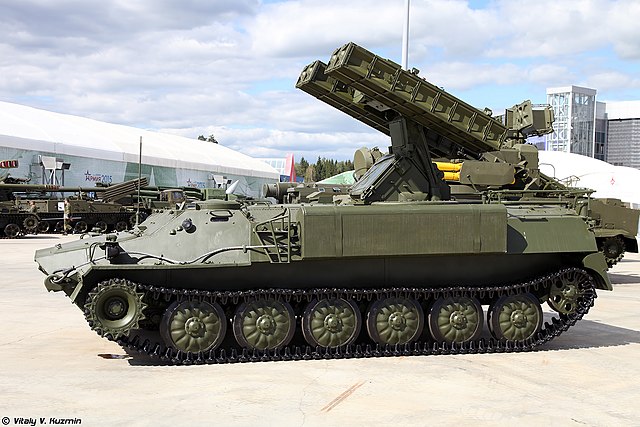
Park Patriot 2015 Strela 10M3
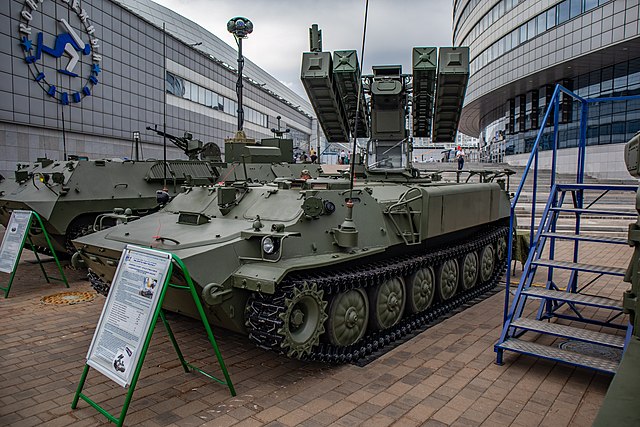
Belarussian Strela-10BM2
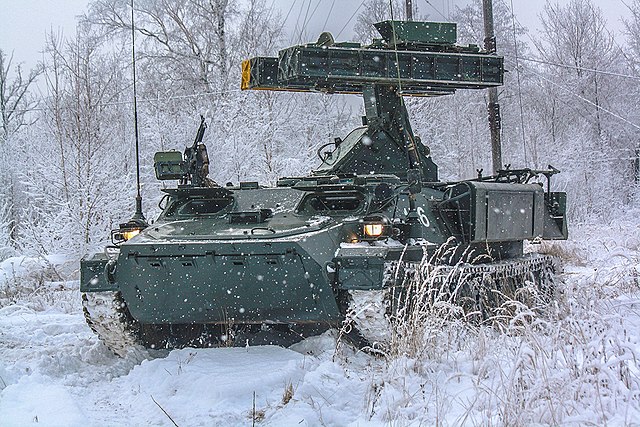
Strela 10MN in 2018
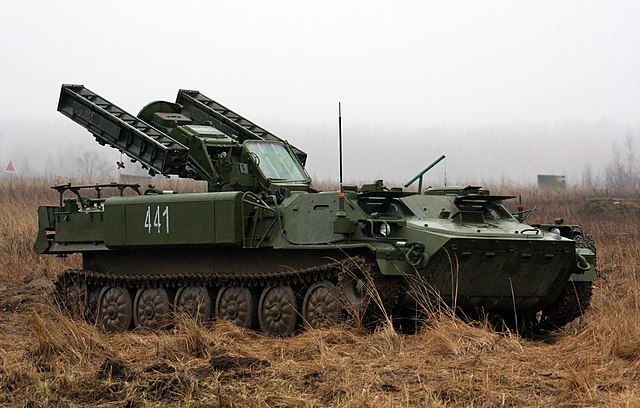
9A34 Strela-10 of the 4th Separate Tank Brigade
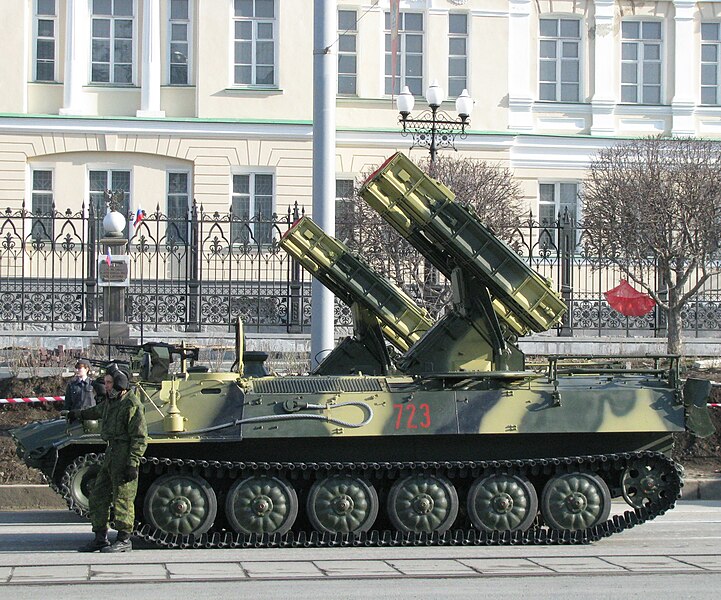
9K35 strela10 in russian Camouflage
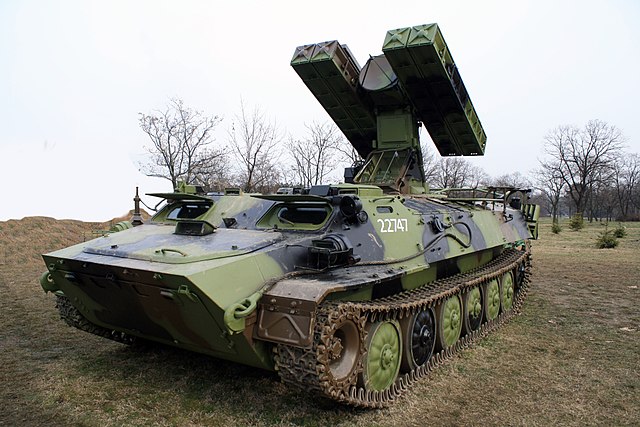
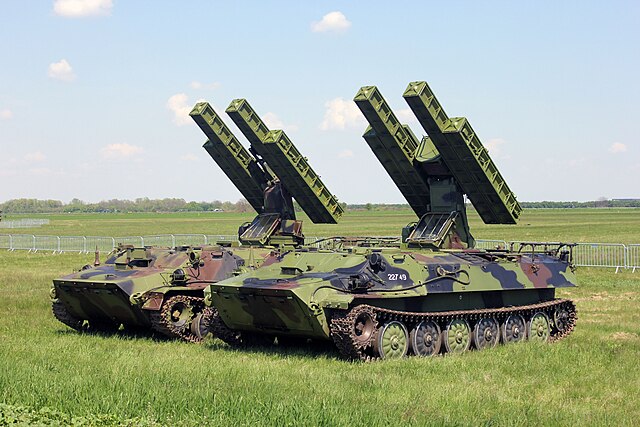
Serbian variant "Granit"
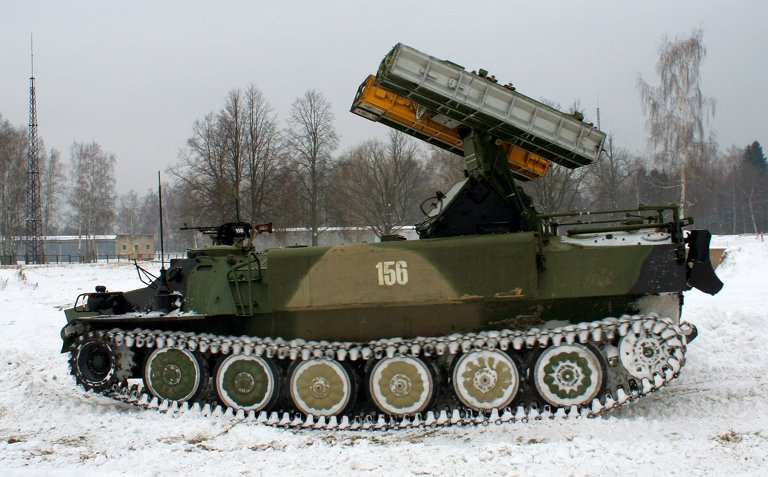
9K35M3 Strela-10M3, 202nd Brigade M.Jerdev 12/2010
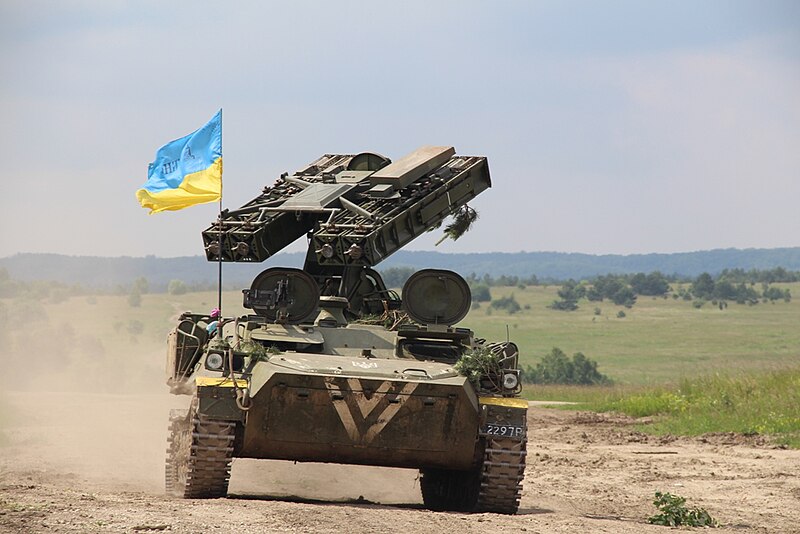
Ukrainian 9K34 Strela 10
Video

Cold War Tanks


































Cold war tanks posters

Cold War Main Battle Tanks

Cold War Soviet Army

